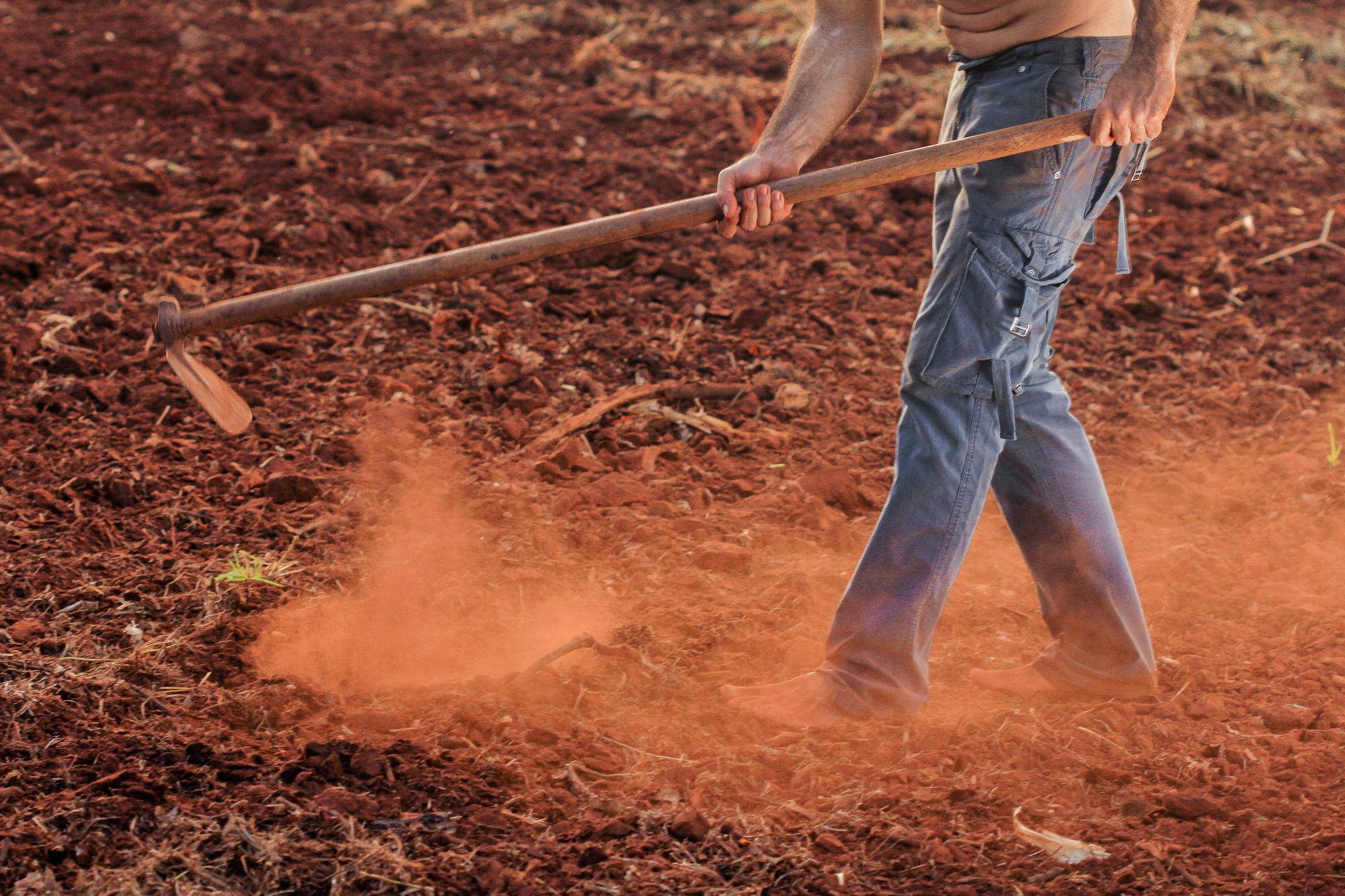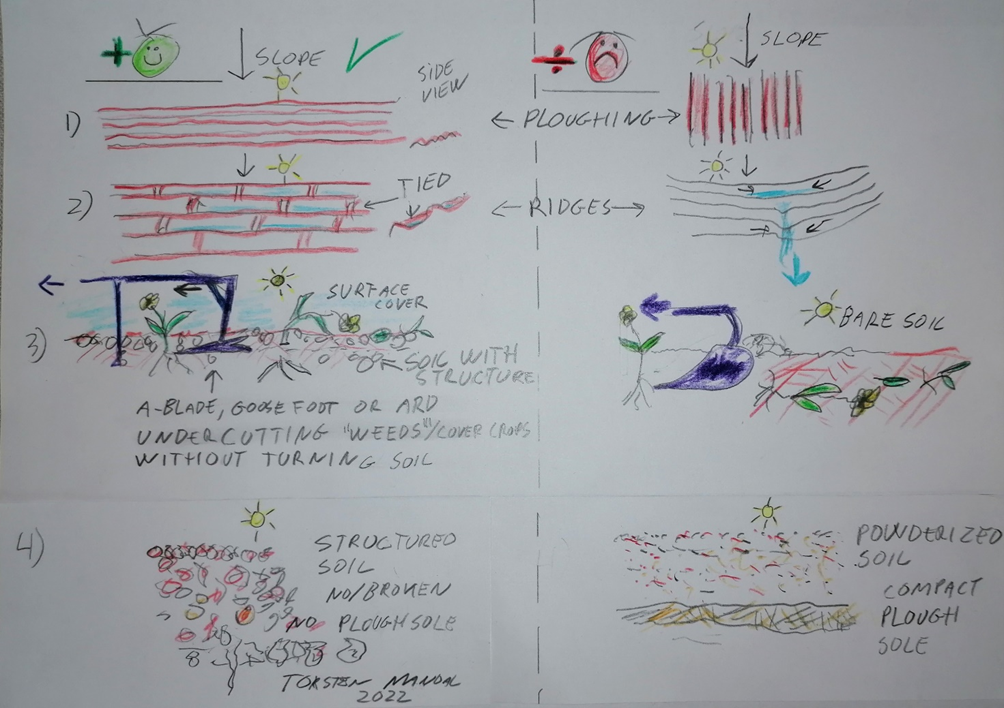Tillage can sometimes help but usually harm soil and water conservation

This post is also available in:
This post is also available in:
![]() Français (French)
Français (French) ![]() Deutsch (German)
Deutsch (German) ![]() हिन्दी (Hindi)
हिन्दी (Hindi) ![]() العربية (Arabic)
العربية (Arabic) ![]() Türkçe (Turkish)
Türkçe (Turkish) ![]() 简体中文 (Chinese (Simplified))
简体中文 (Chinese (Simplified)) ![]() Português (Portuguese (Brazil))
Português (Portuguese (Brazil))
Tillage like ploughing, harrowing, ridging or hoeing can help water to enter the soil and reduce wind at a roughened soil surface, but can often powderise soil and thus making it more erodible and with less protective plants and residues on the surface. It can also make water accumulate, break through and start rill erosion.
Among the Benefits of tillage are the:
- openingcompact surfacesto water infiltration or making it rougher.
- contour tillage(ploughing, ridging, or hoeing) if done well so water does not accumulate at low points and breakthrough in concentrated, fast flows, e.g., using the right directions and/or tied ridging or at least rough, irregular ploughing. Even small random variations in weeding or hoeing can matter. Figure 1, Right, part 1, 2) and 3).
- ripping deep penetration plough pans or other compact subsoils, so water and root enter better. This requires much power. However, some plants can also loosen the subsoil. The effect of loosening a “plough pan”, can be limited if a so-called “plough pan rather” actually is a deeply compacted deeper compact subsoil also below the layer compacted by tractor tires or other loads of traffic. In conservation farming views, plough pans are assumed to be a key problem even for ox-ploughing in Africa. However, cracks from a subsoil tool can go deeper than it reaches directly. Alternatively, some plants can loosen the subsoil. The conservation farming system focuses much on assumed plough soles even for ox-tillage. Figure 1, Right, part 4).
- reducing the need to burncrop residues, use pesticides and improve crop growth.
- terminating cover crops.Some implements (tillage tools)make it easier to maintain plant cover on the surface by undercutting their roots – without turning the topsoil upside down like a typical plough. This horizontal cutting tool can still make it easier to include cover crops and intercrops without using herbicides (chemical weed killers). They are called A-blades, goose-feet, or light, simple wooden ards (=scratch plough) still often used from Morocco to India. Ards can have metal edges. Figure 1, Right 3). Spring tines can remove underground stems of weeds. Animal-drawn multipurpose toolbars can be used for tillage instead. It can have a strong, light, and cheap frame made locally from a hollow pipe (rectangular or round) rather than the outdated, heavy, massive cast iron bars copied from old horse ploughs. An illustrated overview is freely available and explains implement types (Watson 1981). In 1983, students from Wageningen University made further improvements in Machakos in Kenya. Farmers can with these change implements without using any spanner. Also, a standard galvanized steel pipe frame of about 3” diameter was found most appropriate for local production. A wooden beam can also been used.
- water conservation can be obtained by stopping plant growth with tillage in some seasons or contour belts, so more soil is available. If water still enters the soil, it can give more water for other uses, but it can easily damage the soil if it is completely bare.

Figure 1. Tillage and soil conservation
Figure 1. Tillage and soil conservation. Corresponding positive (left) and negative (right) examples. 1) Ploughing across the slope (right) versus along it (left). 2) Use of tied ridges promoting water infiltration (left); ridges causing accumulation of water and erosive flows (right). 3)Tillage tools cutting weed tops from stems but leaving the surface covered (left). A mouldboard plough that turns the weeds and residues under the soil and needs heavier traction. 4) Structured (aggregated, porous) soil with no or a broken plough sole below the topsoil (left); powdered soil with compact plough sole, is low in organic matter due to oxidation (right). By T Mandal 2022.
Tillage can also often increase erosion by:
- If tillage is done up and down the slope, water erosion increases. Unfortunately, tractor drivers may do it anyway for their safety or comfort or to lead off excess water. Figure 1, Right part 1). Likewise, some shapes of the field or irregular slopes can make contour tillage difficult. Water may even collect and start concentrated flows at low places along ridges. Figure 1, Right part 2).
- Making oxygen enter the clods and break down organic matter needed to stabilize the soil pores and water holding and plant growth.
- Removing protecting plants and residues from the soil surface (if the soil is turned). Figure 1, Right part 3).
- Killing of some soil organisms or at least reducing the population compared to permanent plant cover conditions. Nevertheless, soil organisms may recover fast after ploughing, and big earthworms can escape deeper. Other organisms will be disturbed or cut but not killed. More nutrients and plants available to feed them may help them recover.
- Compacting too moist clay, e.g., as plough pansby tractor wheels. In Africa, some claim that ox-ploughing can cause plough pans, but a subsoil can be compact for other reasons as well. Figure 1, Right part 4).
- Cultivating more extensive areas: Mechanised tillage can make it possible to cultivate bigger areas, including slopes and fragile depleted soils. These areas could otherwise have been protected by permanent pasture or forest or a fallow with plant cover.
- Reducing the number of trees and shrubs for making space for tractors or ox-tillage to pass. However, contour hedges can be made with space for working and turning.
- Breaking soil clods and pores between them, so water cannot enter the soil fast. Disc ploughs and disc harrows tend to pulverize soils, as does too much tillage of dry and/or silty soil. The cover photo above to this tillage chapter and Figure 1, Right part 4).
Minimal tillage and alternatives to tillage
To improve the impact of tillage on soil and water conservation, you can avoid turning, powdering, or compacting the soil more than needed, and avoid cultivating up and down the slope or in a way so water accumulates and breakthroughs at a low point or causes landslides. Likewise, to reduce the need for damaging tillage, keep the soil covered with plants (other than problematic live weeds) as much as possible. Also, use crop rotation, intercropping, resistant plant types, and host plants for natural enemies of crop pests (that do not infest the crop).
Alternative to ploughing crop residues into the soil or burning them can be fodder or compost with more nutrient-rich material like the tops of legumes. Trash lines across slopes can be used, but rodents and, e.g., stem borers may hide in them where they are piled. Likewise, intercropping and cover crops can be used to shade out weeds. Cover crops do not always have to be terminated (killed) by tillage or ploughing; instead, the farmer can select to sow species that can be killed by cold or drought. Growing permanent and long-duration crops like trees and grasses can reduce tillage needs.
Managing challenges without moldboard ploughing (turning the soil)
Long-lasting weeds. The perennial weeds are shooting from underground storage organs after the top is cut back – at least if herbicides also are avoided. That can be a challenge for stopping or reducing tillage and ploughing year after year. However, shade and other competition from cover crops and crop residues may help. Untilled contour strips or roadside vegetation can cause mistaken fear that perennial weeds will infest the tilled fields. However, perennial weeds are usually not competitive in a regular tilled and cropped field. Also, lots of dormant weed seeds and underground storage stems (rhizomes) are usually brought to the surface by ploughing. In brief, reduced tillage, or complete no-tillage in contour lines, is much easier than no tillage, at least without herbicides.
Turning the soil can place plant tops deep. However, simply cutting off the tops below the soil surface kills most weeds. It also contributes to depleting the energy store of perennial weeds and delaying weed growth, so crops better can shade them out.
Some harrows, e.g., with spring tines, are also suited to pull roots up to dry on the surface for some problematic weeds reproduced by underground horizontal rhizomes (storage ‘roots’).
Weed spreading from one farm to the other is usually of minor importance (except for new types) compared to the soil’s weed seed “bank” store. Ploughing seeds deep to prevent germination is common. However, some weed seeds can survive deep in the ground for years and can come up by ploughing and germinating when exposed to light. Many seeds will be eaten by animals or die in other ways if exposed to the surface. Likewise, the perennial plants surviving year after year in untilled contour stripes are not likely to be weeds adapted to fields with even minimal tillage. In most cultivated fields, weeds are from seeds germinating and growing quickly in the light.
Soil structure. More organic matter and biological activity, e.g., from conservation farming with cover crops rather than tillage, can also increase soil structure tolerance to tillage and limited tillage systems. Silty soils, low in organic matter, may get a compact surface that tillage can open up for a while.
Tillage to look “tidy. Tillage is sometimes done to show absent landowners or other farmers that the farmer is hardworking and orderly. Therefore, awareness is important in the community of the value of reduced- or no-tillage for erosion, climate, and biodiversity.
Crop residues. Ploughing crop residues into the soil can be less destructive than burning them. This method may reduce wildfires, difficulties with fieldwork, snakes/rodents, pests, and diseases. Additionally, they can protect the soil surface and prevent erosion if placed and aligned so that they are heated by the sun. Suppose too few nitrogen-rich plants and residues are available. In that case, they can decompose slowly and reduce N-availability in N deficient soil when ploughed in because microorganisms must take N from the ground. Therefore, intercropping or covering crops that are legumes and fixing nitrogen can help microbial degradation in the field, in a compost heap, or as fodder as an alternative to burning. Burning will cause the nitrogen and organic matter to be lost, much of the sulphur and at high-temperature potash. Wind or water erosion can easily also remove ash or distribute it poorly.
Nitrogen fertilizers can help use residues low in nitrogen like cereal straw and stalks so they, e.g., can be ploughed in and decompose. Otherwise, the microbes may take up too much nitrogen from fields low in nitrogen for decomposing them and building humus. It is e.g. documented as a problem in African small-scale farming but not in typical farms in Denmark. It can also take extra long time. However, the cheapest types (ammonium sulphate and urea) can acidify soils. Nitrate fertilizers increase pH while calcium ammonium nitrate is generally pH neutral. Soil water extracts with a pH below 5.5 can indicate roots of sensitive plants can be stunted (e.g. common beans). This will often happen in the subsoil first and in the humid tropics and subtropics on reddish or yellowish soils high in exchangeable aluminum. The fertilizer that is used well can increase the production of organic matter from crops (harvested residues and often legumes, fodder, and manure). Growth of weeds, pasture, and trees can also increase, but fertilizers can sometimes make it attractive to suppress weeds, cultivate fragile or ‘exhausted’ soils, and skip methods that conserve and enrich soils. However, less effort, like terracing, may be put into preserving a nutrient-poor field than a more fertile (nutrient-rich) one – if the nutrient-poor cannot be fertilized. Few people understand that fertilizers can help and harm soil conservation and organic matter.
References
Baumhardt RL, and Blanco-Canqui H 2014 Soil: Conservation Practices. In: Neal Van Alfen, editor-in-chief. Encyclopedia of Agriculture and Food Systems 5, Elsevier, 153-165.
Hudson W N 1987 Soil and water conservation in semi-arid areas. Silsoe Associates Ampthill, Bedford United Kingdom. Soil Resources, Management and Conservation Service. FAO Land and Water Development Division. Food and Agriculture Organization of the United Nations Rome, 1987 https://www.fao.org/3/t0321e/t0321e00.htm
Land and Water Division 2000 Manual on Integrated Soil Management and Conservation Practices. FAO land and water bulletin Series number: 1024-6703. 214 pp. ISBN: 9251044171 https://www.fao.org/publications/card/en/c/31f117c4-13e2-5631-bf16-ebaaa10b714f
Muriuki JP, Macharia PN 2011 Green Water Credits Report K12: Inventory and Analysis of Existing Soil and Water Conservation Practices in Upper Tana, Kenya. https://www.isric.org/documents/document-type/green-water-credits-report-k12-inventory-and-analysis-existing-soil-and Open access.
Mandal T. 2010. Low-cost soil and water conservation with many early benefits. Presentation Researchers’ Day: Climate Change Impact, Adaptation and Mitigation GEUS, Inst. of Geography, University of Copenhagen. 7 October 2010. Arranged by the Climate Change Task Force. https://www.yumpu.com/en/document/view/35209735/present-danish-water-forum
Thomas DB et al. 1997. Soil and water conservation manual. Soil and Water Conservation Branch, Min. Agric. Livestock Dev. and Marketing, Nairobi Kenya.
Watene G and others 2021 Water Erosion Risk Assessment in the Kenya Great Rift Valley Region Sustainability 2021, 13(2), 844; https://doi.org/10.3390/su13020844
Watson PR 1981 (ed. R Davis and M S Chakroff). Field operations and implements Animal traction. Manual M0012 Peace Corps Information Collection & Exchange. http://www.nzdl.org/cgi-bin/library.cgi?e=d-00000-00—off-0hdl–00-0—-0-10-0—0—0direct-10—4——-0-1l–11-en-50—20-about—00-0-1-00-0-0-11-1-0utfZz-8-00&a=d&cl=CL1.1&d=HASH0113c7507f62288f1860ce3b.10









































































